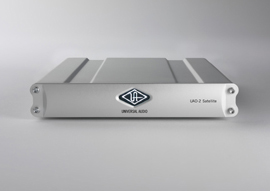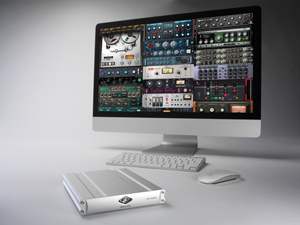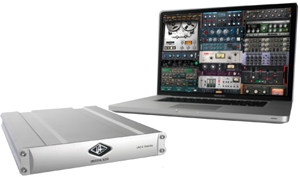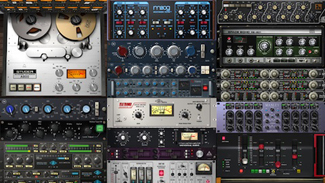Review: The UAD-2 Satellite Quad Firewire DSP Accelerator by Bo Boddie
When Universal Audio first debuted the UAD-1 system in 2001, I have to admit that I didn’t pay it much mind. At that time I was still pretty skeptical about the quality of the mixes that I could get out of mixing in-the-box (ITB), and only used plug-ins for minor utility work and making roughs. Most of the work I was doing was in recording studios anyway, so I had access to great gear – why would I use a plug-in 1176 when I could insert a real one? However, I always liked the idea that I would someday be able to work completely within the computer and still get the results I was after.
A lot has changed in the music production world since 2001… CPU power has grown exponentially, and the quality and flexibility of both DAW software and plug-ins along with it. Engineers and producers who are so inclined have adapted to the idiosyncrasies of working ITB, adjusting working methodologies to compensate for the differences between the analog and digital domains, and it is becoming commonplace for us to make great sounding records without all of that analog outboard that set the bar so high.
And as a specific milestone on the timeline, I still remember the first time I used the UAD plug-ins. Between 2003-2008 I used to work at Stratosphere Sound (shout out to Geoff Sanoff!) pretty frequently and they had UAD-1 cards in both of their rooms. During one session there, with an artist who was on Island records at the time, I decided to check out the UAD 1176 just out of curiosity. For someone who didn’t really care about using plug-ins, it was a big moment. It actually sounded like a real compressor! I was pretty floored and so I went and did the research on the UA software products.
Although I was skeptical of having to add a PCI card for processing, I liked the commitment that they had made to creating emulations that went the extra mile, and so said, required the additional DSP to do the convincing work.
These days I do most of my production work in my home studio, and so last year I purchased a UAD-2 card. Although the Mac Pro I use has a ridiculous amount of power which I have yet to max out, I still had that lingering memory of the first time I used the UAD-1 at Stratosphere, and growing gear envy over the ever-expanding line of UAD plug-ins. I was sold on the plug-ins; the fact that all processing took place on the PCI card was just an added benefit.
When SonicScoop asked me if I wanted to review the new UAD-2 Satellite Quad – Universal Audio’s new Firewire 400/800 UAD-2 plug-in platform (with Quad processing power) – I jumped on it. I was really curious to see how well the system would work over Firewire, and hoped I’d also get to try it out with my laptop.
SIMPLE SETUP
If you are new to the UAD system, the setup is extremely easy. The Satellite ships with the latest version of the UAD software, which includes all of the plug-ins (more on that later), all necessary drivers, and the metering and control panel application through which all features and authorizations are managed. The Satellite requires that you use software version 5.8.1, in which the “.1” offers the Firewire support.
If you don’t already have a UAD account, you will need to create one, as it is a necessity for managing plug-in and hardware authorizations.
The software must be installed first, after which, authorizing the Satellite is as simple as turning it on and plugging it into either a Firewire 400 or 800 port. To complete the authorization, you must click the “authorize plug-ins” button. Without following the instructions it took me a moment to remember this, maybe it would be a little more self-evident if there was a separate button for hardware authorization, but it’s hardly a sticking point.
Clicking the button brings you to the user area of the UAD website, and it is here that your system is recognized and authorized. As with all UAD authorizations, both software and hardware, a file is downloaded through your web browser which must then be dragged into the window of the UAD system software; which in turn enables the use of the hardware/software.
All versions of the Satellite include a stellar collection of plug-ins, which Universal Audio calls the “Analog Classics”:
2. Pultec Pro
3. Realverb Pro
4. LA-2A
All of the other UAD plug-ins are pre-installed along with the system software, and have 14 day demo periods which can be authorized through the control panel, or via instantiating the desired plug-in from within the DAW environment — a dangerous proposition to be sure, given the amazing sounds you are sure to get! An extensive manual is included on the CD-ROM, which details all of these steps, as well as detailed descriptions of all of the plug-ins.
IN USE
I was pleasantly surprised at how well the system works over the Firewire bus. I tested it at both 400 and 800 speeds, in both Logic and Pro Tools 9, and although less plug-ins can be used with lower data bandwidth, using the Firewire 400 bus did not seem to radically affect performance.
The UAD control panel offers extensive control over how the Firewire bus is used, and allows the user to make decisions about how much Firewire bandwidth is allocated for the card’s usage. This is a wonderful feature given that there will almost certainly be other devices on the Firewire bus, either drives or an audio interface, and being able to have some control over how data bandwidth is distributed is paramount.
Universal Audio recommends that the Satellite always be the first device in the daisy chain, if there is one. The Satellite does not distribute bus power to devices that may need it, so that will also be a consideration. The manual offers a several different connection schemes, all of which were helpful. I tried many different configurations myself, and I’m happy to report that the Satellite worked well in all of them.
All of this said, it is preferable to use Firewire 800, simply to maximize the power of the DSP card. The Satellite uses the same SHARC DSP cards as its PCI-based brothers, the only difference being the way it interfaces with the CPU. There is no question that more plug-ins can be used with PCI-based cards, however, the Satellite’s major offering is its portability and compatibility on computers without PCIe, like MacBook Pros and iMacs.
It is here that we see the one major difference between the Firewire and PCI based systems: LiveTrack mode cannot be used with the Satellite. The major consideration with all of the UAD systems is latency. Sending audio data out to an add-on card for processing, either PCI or Firewire, creates significant latency. Hence, tracking with a UAD plug-in instantiated can be difficult, and the PCI-based UAD-2 cards and software introduced a low-latency mode (LiveTrack) as a workaround for those of us want to use the plug-ins while tracking.
Because of the lower data throughout offered by the Firewire interface, this option is not available with the Satellite. For me, this certainly isn’t a deal-breaker, as I rarely incorporate any software-based processing while tracking; as long as I can mix with the plug-ins I’m happy. Perhaps we will see a UAD Satellite in the future that incorporates Apple’s new Thunderbolt interface protocol, which would undoubtedly offer the data bandwidth necessary to include this forgone option.
The only issue I had with the Satellite will not be a factor for most of you, but may possibly save a few people the disappointment of discovering too late that their laptop is not compatible, as was the case with my 2007 Core 2 Duo MacBook. The Satellite works with Intel-Based iMacs, select MacBook Pros and Mac minis. Just make sure you check out the UAD-2 Satellite Support Page to find your hardware on the list of compatible systems.
As you’ll see, the Satellite works best with later model MacBook Pros, iMacs, Mac Minis and Mac Pros, and is partially compatible – running at FireWire 400 speed, but requiring an adapter to run at FireWire 800 speed – with earlier models of MacBook Pro, Mac Pro and iMac. Based on how well it worked with my desktop system at both Firewire 400 and 800 speeds, I can only assume it would work perfectly on any of the systems on the list.
CONCLUSIONS
In my mind, there is one compelling reason to use this product, and that is to have access to the dizzying array of analog emulations that Universal Audio has developed. They all sound fantastic, and have made a noticeable difference in my ability to more easily pull off great sounding ITB mixes.
While I was only able to use the Satellite with my Mac Pro for this review, the ease of set-up was fantastic, and I really enjoyed having 4 extra chips worth of power with which to go hog-wild with the plug-ins for a few weeks.
I should note, that even with my DUO PCI card alone, I usually do not max out the available DSP. A friend recently asked me if I thought the Satellite would be a good addition to his TDM Pro Tools system, as he had run out of PCI slots. After seeing how solidly the Firewire interface has worked I can say yes!
The UAD-2 Satellite comes in several different configurations: DUO (2 chips) with $50.00 voucher ($899.00); DUO FLEXI with $500.00 voucher ($1,199.00); QUAD (4 chips) with $50.00 voucher ($1,499.00); QUAD Flexi with $500.00 Voucher ($1,799.00); and QUAD OMNI with all the UAD plug-ins up to version 5.7 ($4,499.00). Visit http://www.uaudio.com/uad-plug-ins.html for the full range of UAD-2 powered plug-in systems.
Bo Boddie is a Grammy winning engineer/producer and composer who has worked with Santana, Everlast, Korn, Reni Lane, and many others. He is currently beginning work on Imperial Teen’s second release on Merge Records. Also check out Psychic Friend, his new band with Will Schwartz (Imperial Teen) and Patty Schemel (Hole).
Please note: When you buy products through links on this page, we may earn an affiliate commission.












Gugulethu
May 3, 2011 at 9:30 pm (14 years ago)I believe the UAD-2 are the best tools for mixing music. Some one once told me that it would be better if I get a good sound card than these haha, but I think I’m going to get myself this UAD-2 Quad. Thanx for the review, really great 🙂
Rpwbass
May 4, 2011 at 12:07 am (14 years ago)You won’t be sorry. Get a good sound card/converter when you can, though. It’s the combination that will get you all the way there!
Gugulethu
May 4, 2011 at 7:37 am (14 years ago)Thank You 🙂
Mdsystem1
May 5, 2011 at 8:58 pm (14 years ago)Now we just need to wait for the Thunderbolt version of this interface, match it up with a new MacBook Pro with Thunderbolt capability and we should be all set to have full ProTools HD on a laptop studio.
Rajesharma
May 6, 2011 at 10:28 am (14 years ago)I have looked at the deals and are you sure that you get the plugins (Fairchild etc.) as standard?
Janice
May 8, 2011 at 3:32 pm (14 years ago)Actually, you’re right that the Fairchild is not included with the Analog Classics. No UAD-2 version includes the Fairchild — except the Omni package, which includes everything up to version 5.7. The “Analog Classics” bundle that does come standard with the UAD-2 Satellite systems includes the LA-2A, 1176LN / 1176SE, Pultec EQP-1A and Realverb Pro plug-ins.
Rajesharma
May 8, 2011 at 6:12 pm (14 years ago)Thanks for the useful information:)
Jasica sarah
November 13, 2011 at 2:25 pm (14 years ago)Universal Audio UAD2 Solo Laptop DSP
This Universal Audio UAD-2 Quad DSP Accelerator Card is a merge with the
most current trends within audio Mixing intended for both Media as well
as Music
industry. Due to using this premier brand that lots of International
known Musicians, Producers plus Broadcasters have earned accolades as
well as awards for themselves.
http://www.dspcards.com/universal-audio/universal-audio-uad2-solo-laptop-dsp-accelerator-card
LCD Drawer
December 8, 2011 at 5:53 am (13 years ago)As a musician, I don’t give two shits about how they do it, really. I
just care if it sounds really good. From what I’ve read UAD’s models
SOUND REALLY GOOD … if I need hard drive sized dongle at the end of a
firewire cable to make that happen … well that might kinda suck, but if
it sounds really good, I don’t actually care that much.